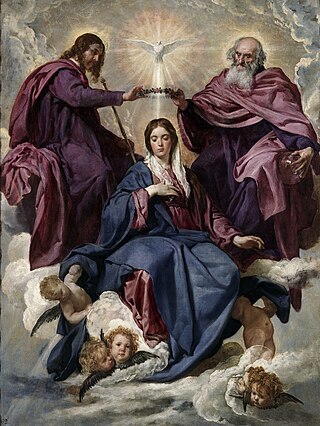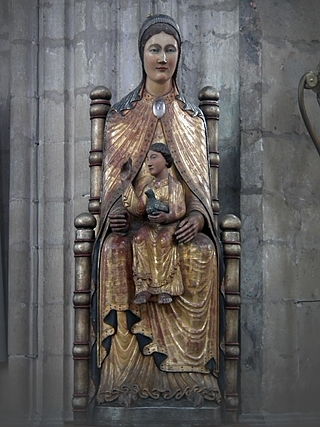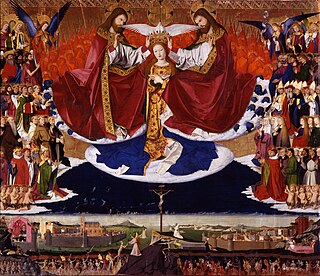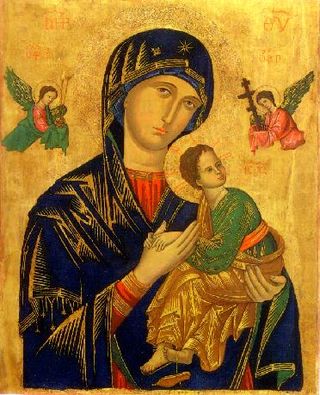
In art, a Madonna is a representation of Mary, either alone or with her child Jesus. These images are central icons for both the Catholic and Orthodox churches. The word is from Italian ma donna 'my lady' (archaic). The Madonna and Child type is very prevalent in Christian iconography, divided into many traditional subtypes especially in Eastern Orthodox iconography, often known after the location of a notable icon of the type, such as the Theotokos of Vladimir, Agiosoritissa, Blachernitissa, etc., or descriptive of the depicted posture, as in Hodegetria, Eleusa, etc.

The term Black Madonna or Black Virgin tends to refer to statues or paintings in Western Christendom of the Blessed Virgin Mary and the Infant Jesus, where both figures are depicted with dark skin. Examples of the Black Madonna can be found both in Catholic and Orthodox countries.

Queen of Heaven is a title given to the Virgin Mary, by Christians mainly of the Catholic Church and, to a lesser extent, in Anglicanism, Lutheranism, and Eastern Orthodoxy. The title has long been a tradition, included in prayers and devotional literature and seen in Western art in the subject of the Coronation of the Virgin from the High Middle Ages, long before it was given a formal definition status by the Church.

The Litany of the Blessed Virgin Mary is a Marian litany originally approved in 1587 by Pope Sixtus V. It is also known as the Litany of Loreto, after its first-known place of origin, the Shrine of Our Lady of Loreto (Italy), where its usage was recorded as early as 1558.

Maestà[maeˈsta], the Italian word for "majesty", designates a classification of images of the enthroned Madonna with the child Jesus, the designation generally implying accompaniment by angels, saints, or both. The Maestà is an extension of the "Seat of Wisdom" theme of the seated "Mary Theotokos", "Mary Mother of God", which is a counterpart to the earlier icon of Christ in Majesty, the enthroned Christ that is familiar in Byzantine Mosaics. Maria Regina is an art historians' synonym for the iconic image of Mary enthroned, with or without the Child.

The Basilica della Santa Casa is a Marian shrine in Loreto, in the Marches, Italy. The basilica is known for enshrining the house in which the Blessed Virgin Mary is believed by some Catholics to have lived. Pious legends claim the same house was flown over by angelic beings from Nazareth to Tersatto, then to Recanati, before arriving at the current site.

The shrine to Our Lady of Guadalupe was the most important Marian shrine in the medieval kingdom of Castile. The image is enshrined in the Monastery of Santa María de Guadalupe, in today's province of Cáceres in the Extremadura autonomous community of Spain.

Our Lady of Good Counsel is a title given to the Blessed Virgin Mary, after a painting said to be miraculous, now found in the thirteenth century Augustinian church at Genazzano, near Rome, Italy. Measuring 40 to 45 centimetres the image is a fresco executed on a thin layer of plaster no thicker than an egg shell. Over the centuries, devotions to Our Lady of the Good Counsel grew among saints and Popes, to the extent that a reference to it was added to the Litany of Loreto and the devotion spread throughout the world. Her feast day is 26 April.

The Sedes Sapientiae, also known as Our Lady of Leuven, is a Medieval wooden statue of the Virgin Mary located at St Peter's Church in Leuven, Belgium. It was carved in 1442 by Nicolaas De Bruyne as an enlarged copy of an earlier statue from the 13th century. The polychromy was done by Roelof van Velpen. It was restored in 1842 and 1945. A longstanding local landmark, the statue was depicted on the seals of the Katholieke Universiteit Leuven and UCLouvain.

The Coronation of the Virgin or Coronation of Mary is a subject in Christian art, especially popular in Italy in the 13th to 15th centuries, but continuing in popularity until the 18th century and beyond. Christ, sometimes accompanied by God the Father and the Holy Spirit in the form of a dove, places a crown on the head of Mary as Queen of Heaven. In early versions the setting is a Heaven imagined as an earthly court, staffed by saints and angels; in later versions Heaven is more often seen as in the sky, with the figures seated on clouds. The subject is also notable as one where the whole Christian Trinity is often shown together, sometimes in unusual ways. Crowned Virgins are also seen in Eastern Orthodox Christian icons, specifically in the Russian Orthodox church after the 18th century. Mary is sometimes shown, in both Eastern and Western Christian art, being crowned by one or two angels, but this is considered a different subject.

Mary, the mother of Jesus in Christianity, is known by many different titles, epithets, invocations, and several names associated with places.

Catholic art is art produced by or for members of the Catholic Church. This includes visual art (iconography), sculpture, decorative arts, applied arts, and architecture. In a broader sense, Catholic music and other art may be included as well. Expressions of art may or may not attempt to illustrate, supplement and portray in tangible form Catholic teaching. Catholic art has played a leading role in the history and development of Western art since at least the 4th century. The principal subject matter of Catholic art has been the life and times of Jesus Christ, along with people associated with him, including his disciples, the saints, and motifs from the Catholic Bible.

Mary has been one of the major subjects of Western Art for centuries. There is an enormous quantity of Marian art in the Catholic Church, covering both devotional subjects such as the Virgin and Child and a range of narrative subjects from the Life of the Virgin, often arranged in cycles. Most medieval painters, and from the Reformation to about 1800 most from Catholic countries, have produced works, including old masters such as Michelangelo and Botticelli.

Refugium Peccatorum meaning Refuge of Sinners is a Catholic title for the Blessed Virgin Mary. Its use goes back to Saint Germanus of Constantinople in the 8th century.

The Virgin of Mercy is a subject in Christian art, showing a group of people sheltering for protection under the outspread cloak, or pallium, of the Virgin Mary. It was especially popular in Italy from the 13th to 16th centuries, often as a specialised form of votive portrait; it is also found in other countries and later art, especially Spain and Latin America.

The Annunciation has been one of the most frequent subjects of Christian art. Depictions of the Annunciation go back to early Christianity, with the Priscilla catacomb in Rome including the oldest known fresco of the Annunciation, dating to the 4th century.

The Virgin from Ger is a 12th century sculpture exhibited at the National Art Museum of Catalonia in Barcelona.

The Santuario della Madonna Consolata is a Marian sanctuary and minor basilica in central Turin, Piedmont, Italy. Colloquially, the sanctuary is known as La Consolata. It is located on the intersection of Via Consolata and Via Carlo Ignazio Giulio. The shrine is dedicated to the Blessed Virgin Mary under the title of Our Lady of Consolation.

Italo-Byzantine is a style term in art history, mostly used for medieval paintings produced in Italy under heavy influence from Byzantine art. It initially covers religious paintings copying or imitating the standard Byzantine icon types, but painted by artists without a training in Byzantine techniques. These are versions of Byzantine icons, most of the Madonna and Child, but also of other subjects; essentially they introduced the relatively small portable painting with a frame to Western Europe. Very often they are on a gold ground. It was the dominant style in Italian painting until the end of the 13th century, when Cimabue and Giotto began to take Italian, or at least Florentine, painting into new territory. But the style continued until the 15th century and beyond in some areas and contexts.





















